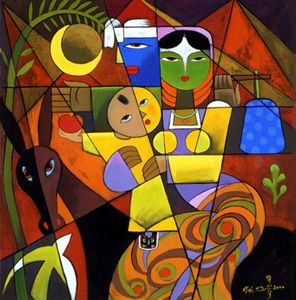World Christianity Explored through World Art
What is world/global Christianity?
I would like to answer this question from the perspective of my study of art and theology. Maybe aesthetic reflection can provide some insights that are not available through the propositional reasoning that is usually associated with ‘theologizing.’

Let’s look at the story of the contemporary Chinese artist He Qi [pronounced Huh Chee], and then at his painting The Flight to Egypt (2001). He Qi (1951) grew up in China during the Cultural Revolution (1966-1976). Having had some art lessons as a youth, he started painting Mao portraits in order to escape hard labor on the fields. One day he saw Rafael’s painting of Madonna and Child in an old art magazine.
He was drawn immediately to the peaceful smile of Jesus’ mother, which led to his interest in Christianity. He Qi studied medieval art at the Hamburg Art Institute, Germany and then went on to received his doctorate from the Nanjing Art College in Religious Art in 1993 (the first in China). Religious art from the middle ages almost always shows biblical scenes with European-looking people, in European settings. This inspired He Qi to depict biblical stories with a Chinese background, and Chinese characters. He Qi’s work shows the influence of medieval European art, as well as his familiarity with Chinese folk art, such as woodcuts, paper cutting, traditional weaving and embroidery.
Already in introducing the painter we have an amazing global connection of time and space: a 16th century Italian painting of a Christian theme speaks to a Chinese teenager, who becomes a Christian, studies art in Germany and ends up a contemporary Christian artist whose images are used to illustrate Christian books, with exhibits worldwide.
Now let’s give some attention to the painting itself. In the story of the flight to Egypt, Joseph leads Mary and the little child Jesus to safety in Egypt (Matt 2:13-15). These three verses of Scripture have inspired numerous painters.




The geometrical blocks of imagery remind us of stain glass windows, so prominent in European Christian art. He Qi however, uses very bold colors, not traditional in stained glass art, and Chinese themes. And so he accomplishes his purpose of making us reflect on this painting by presenting us with the familiar (known Bible story, known art form of stained glass, recognizable figurative elements) while at the same time challenging our perception by using attention-grabbing colors, boldly intersecting lines, and Chinese themes that have been explained elsewhere.
Could this be what world Christianity entails? The familiar draws us in – we use the same Book, a similar format of worship, and there are recognizable figures in Scripture, church history and in the local church (e.g. ushers, preacher, choir, etc.) – we feel at home. And yet there are the unfamiliar elements that can be unsettling: the colors, sounds and smells are different; bodily movements go against our grain; and local themes need to be studied in order to be understood.
Maybe this painting can be analogous to the concept of world Christianity: let us acknowledge that there is often a dissonance, a discrepancy between the image (i.e. expression) of the way we always imagine Christianity in our minds and Christianity as it is lived out and portrayed in other places of the world. This difference is often not a matter of ‘right and wrong’, but rather the result of the various factors that make my life different from someone else’s life. In the case of art, the dissonance creates space for explorations of multiple interpretations. In the case of world Christianity, it allows space for the ambiguity of not knowing everything, of giving God and people space to express and live Christianity in their own, inimitable way.
Francisca F. Ireland-Verwoerd
PhD Student in Practical Theology, School of Theology